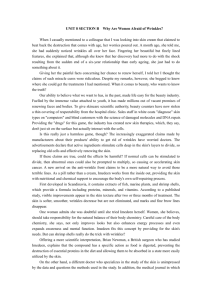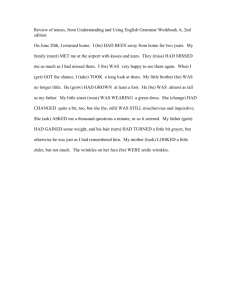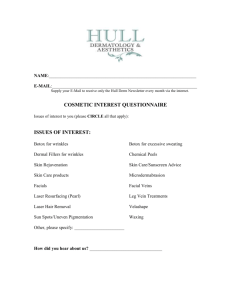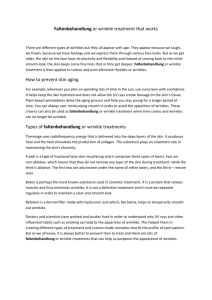Aging in America
advertisement
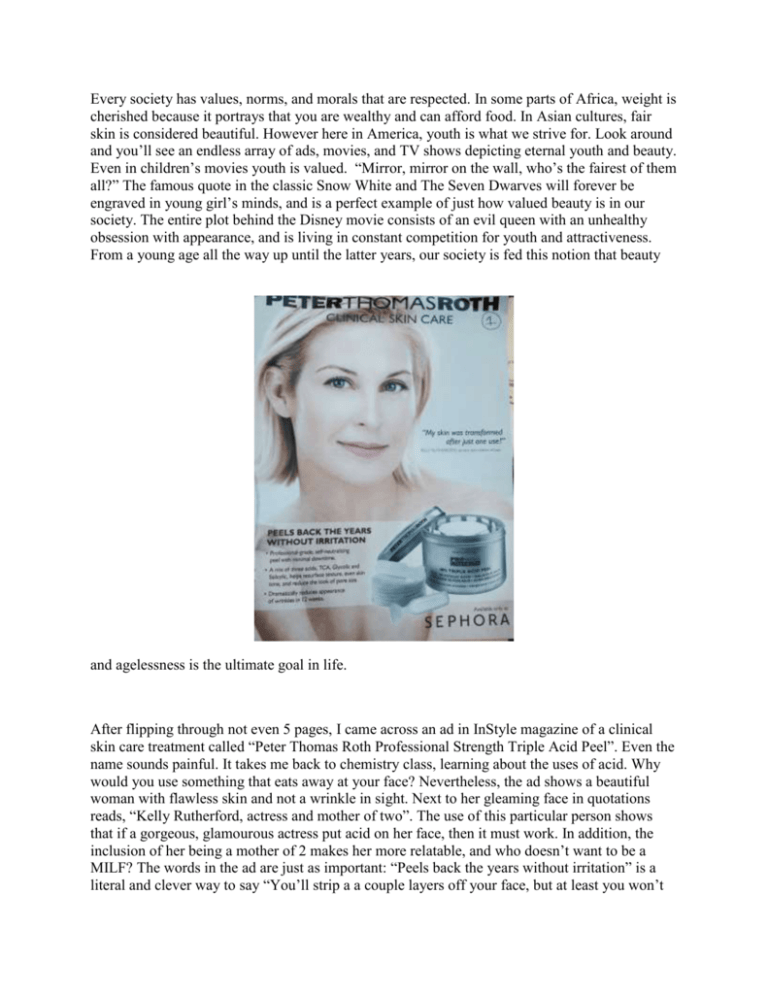
Every society has values, norms, and morals that are respected. In some parts of Africa, weight is cherished because it portrays that you are wealthy and can afford food. In Asian cultures, fair skin is considered beautiful. However here in America, youth is what we strive for. Look around and you’ll see an endless array of ads, movies, and TV shows depicting eternal youth and beauty. Even in children’s movies youth is valued. “Mirror, mirror on the wall, who’s the fairest of them all?” The famous quote in the classic Snow White and The Seven Dwarves will forever be engraved in young girl’s minds, and is a perfect example of just how valued beauty is in our society. The entire plot behind the Disney movie consists of an evil queen with an unhealthy obsession with appearance, and is living in constant competition for youth and attractiveness. From a young age all the way up until the latter years, our society is fed this notion that beauty and agelessness is the ultimate goal in life. After flipping through not even 5 pages, I came across an ad in InStyle magazine of a clinical skin care treatment called “Peter Thomas Roth Professional Strength Triple Acid Peel”. Even the name sounds painful. It takes me back to chemistry class, learning about the uses of acid. Why would you use something that eats away at your face? Nevertheless, the ad shows a beautiful woman with flawless skin and not a wrinkle in sight. Next to her gleaming face in quotations reads, “Kelly Rutherford, actress and mother of two”. The use of this particular person shows that if a gorgeous, glamourous actress put acid on her face, then it must work. In addition, the inclusion of her being a mother of 2 makes her more relatable, and who doesn’t want to be a MILF? The words in the ad are just as important: “Peels back the years without irritation” is a literal and clever way to say “You’ll strip a a couple layers off your face, but at least you won’t have wrinkles!” I didn’t know humans were supposed to shed. The ad lists some big words and names of chemicals that you won’t know and goes on to saying it “reduces appearance of wrinkles.” All in all, it conveys that flawless skin means no wrinkles, avoidance of aging skin, and apparently a tolerance of pain. The second advertisement I found is “Clarins Double Serum Complete Age Control Concentrate.” Apparently there is a way to control age. Although though there is no magnificent portrait of an unblemished woman, the text used in the ad is just as powerful. “Anti-aging” and “Age-Defying” are just a few. “...targets visible signs of skin aging” is another phrase emphasizing the negative view of becoming older. The ad draws the viewer’s eye to statistics and ridiculously large percentages of successful results such as “firmer skin” and of course, “reduced wrinkles”. Who are these women who are being tested? Are these statistics even accurate? The overall message of the ad is, as previously mentioned, to refrain from aging and it is clear in the language that Clarins uses. The third magazine advertisement includes the image of the product, “CoverGirl + Olay Simply Ageless Foundation” in the center of the page, along with an eye dropper and subtle images of beakers in the background. This is to emphasize the science aspect of the product, as if the photograph was taken in a laboratory setting while the substance was being formulated. This is portraying that the product is scientifically proven to reduce the look of aging. In bold letters reads, “SCIENCE IN”, again supporting the idea that the makeup produces scientifically successful results. Mind you, there are no statistics or information regarding an experiment or actual test results. It is even blatant in the name itself, “Ageless” that age is a negative phenomenon. It includes “Years off”, as well as the statement that “makeup can make you look older”, and it “builds up in little lines and wrinkles and make them look worse.” The ad states that the product “allows it to float over lines and make them seem to disappear.” It sounds more like a magic trick than “scientifically” proven. This advertisement is destructing esteem and contributing to women’s poor self-image on two different levels. First, it is claiming that makeup is necessary to be beautiful in the line “Olay Science + CoverGirl Beautiful”. Second, it is saying that wrinkles are flaws, which they then assume women should cover up with makeup. This advertisement conveys that makeup is a necessity for beauty and the goal is to make wrinkles and age disappear. Even though the assignment only requires 3 ads, I found another I felt I had to include simply because it’s so ridiculous. It’s called the “BMR Facial Toner”, and goes beyond the usual creams and lotions to dissolve away wrinkles. It’s an electronic device that uses electrotherapy to rejuvenate and strengthen the muscles in your face, in order to firm skin. Honestly it looks like the woman in the ad put headphones on wrong, perhaps mistaking it for a BlueTooth. The ad shows yet again a stunning woman with non-existent pores, perfect facial structure and not a wrinkle to be found. Wrapped around her immaculate head is a contraption straight out of Star Wars, delicately hugging her cheekbones. Written in the text is “Natural Beauty”, and below reads “As you age, muscle loss can cause your face to sag...” It also emphasizes the idea that you are now able to get top of the line surgery and spa results in the comfort of your own home, resulting in “beauty from the inside out.” The whole notion behind this ad is that saggy skin isn’t hot. Creams and makeup may temporarily conceal flawed skin, but a device that works within the facial muscles guarantees “natural beauty.” Seeing this ad, I couldn’t help but laugh. Has our society gotten so absorbed in youthful beauty that people are wearing strange face headphones? Is it necessary to invent exercise for our faces? Pretty soon local gyms will provide this facework out product. Next time you go to Planet Fitness don’t be surprised if you see a woman with a buff face wearing the Facial Toner. It’s inevitable that all of these advertisements do one thing. They inject into our sponge-like minds this “norm” of what beauty and youth are, and that they define you. They bombard us with unrealistic images and meaningless words that are all socially constructed and force you to agree with their standard of beauty. Society interprets this message by believing wrinkles and everything that naturally comes along with age is unwanted and ugly. Women especially are victims of this because they are expected to be beautiful their entire lives, regardless of age. Even men are effected by this because their standards are raised for how an ideal women should look. This results in the never ending pressure to conform to society’s supreme image. On an individual level, these advertisements impact people’s self-esteem and creates the idea that aging is a downward spiral into ugliness. Youth is prized and the ultimate goal is to do the impossible, which is to maintain it forever. This applies to the Internal Continuity Theory, which is the notion of yourself as you age. Rather than promoting self acceptance and embracing age, society teaches us as individuals to reject a natural occurrence and harasses you until you conform. Not only do these ads shape people’s esteem, they change their behavior as well. After constantly absorbing this type of media, page after page, channel after channel, individuals (particularly older women and sadly, some younger women) give in to these ads. They dispose their money for futile creams, operations, and absurd facial exercise devices to achieve this ludicrous portrayal of youthful beauty. They pay to get needles stuck in their face and inject foreign, man-made chemicals into their cheeks. They empty their pockets for substances that sound more like a science project than a cream. These lotions are ineffective, never mind torturous. Beauty is pain, right? I Googled “Ways to get rid of wrinkles”, and “How to Get Rid of Frown Lines” showed up. Why do we label these “frown lines”? Why not “smile lines”? Why can’t society mold our views into a more positive perspective and reward ourselves for having wrinkles? Rather than viewing wrinkles as a negative aspect of aging, we should be proud of all the times we smiled, laughed, and enjoyed life instead of worrying abut petty things like lines in our skin. Naturally, society views older people in a cynical light. We see them as slow, ignorant, grumpy, annoying, ugly, to name a few. “Elderly” people are the ones that drive 10 miles below the speed limit, lack control of their bodily functions, and tell the same story over and over again because their memory is now but a memory. As mentioned in lecture, our society has even created inappropriate slurs for older people, such as “Old Fart” or “Old Geezer”. These are no different than racial slurs, or negative names against gender or sexual preferences. We are so compulsively engrossed in the idea of beauty that we automatically think age as something to be avoided, even though there is no way to even do this (no matter what products say). Sagging skin, white hair, varicose veins, breasts that hit the floor. These are all our ideas of what aging is, when really, it is something that is inevitable and should be respected rather than rejected. We should accept the fact that we get old and view the process as aging fine wine. Why would you want to be a box of Franzia when you could be a delectable, aged and imported bottle of Riesling?
